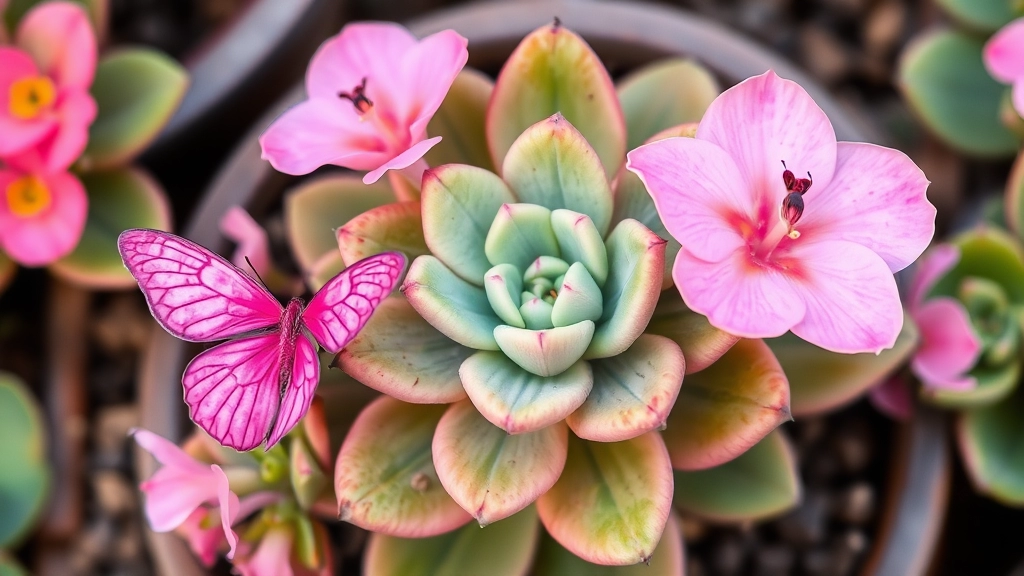Kalanchoe Pink Butterflies Succulent Care
The Kalanchoe Pink Butterflies succulent is a captivating plant known for its striking pink plantlets that resemble butterflies. If you’re looking to add this unique succulent to your collection, understanding its care needs is essential. Let’s dive into the ideal growing conditions and tips to keep your Kalanchoe Pink Butterflies thriving.
Light Requirements
First, ensure your succulent gets plenty of bright, indirect sunlight. Whether you’re growing it indoors or outdoors, proper lighting is crucial.
Watering Tips
Overwatering is a common mistake, so water sparingly and let the soil dry out between watering sessions.
Soil Type
Opt for well-draining soil to prevent root rot and maintain a healthy plant.
### Ideal Growing Conditions for Kalanchoe Pink Butterflies
Are you struggling to keep your Kalanchoe Pink Butterflies thriving? Understanding their ideal growing conditions can make all the difference.
#### Light Requirements
Kalanchoe Pink Butterflies thrive in bright, indirect sunlight.
– **Indoor Placement**: A south-facing window is perfect, providing ample light without direct exposure.
– **Outdoor Placement**: If you choose to place them outside, ensure they are in a spot with filtered sunlight, especially during the hottest part of the day.
#### Watering Tips
Overwatering is a common pitfall for many succulent owners.
– Water only when the top inch of soil feels dry. For more detailed watering advice, check out these [optimal watering tips for healthy Florist Kalanchoe](https://planthq.org/optimal-watering-tips-for-healthy-florist-kalanchoe/).
– Use well-draining soil to prevent root rot.
#### Soil Types
The right soil can significantly impact your plant’s health.
– A cactus or succulent mix is ideal, as it allows for proper drainage.
– You can also create your own mix by combining potting soil with sand or perlite.
#### Temperature and Humidity
Kalanchoe Pink Butterflies prefer a warm environment.
– Aim for temperatures between 15°C to 25°C.
– They are not fans of high humidity, so keep them in a drier spot. If you want to dive deeper into care techniques, read this [complete guide to growing Kalanchoe Mother of Thousands](https://planthq.org/complete-guide-to-growing-kalanchoe-mother-of-thousands/).
Light Requirements: Indoor vs Outdoor Placement
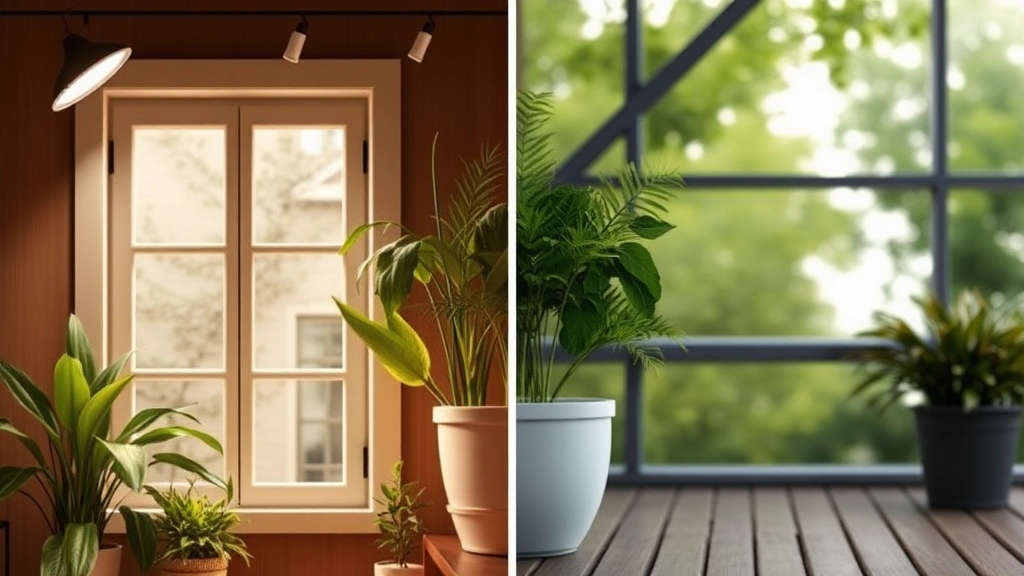
So, you’ve got your Kalanchoe Pink Butterflies and you’re wondering where to put it, right?
Light is everything for these beauties, and getting it right can make all the difference in how they thrive.
Indoor Placement
If you’re keeping your Kalanchoe indoors, aim for a spot that gets plenty of bright, indirect sunlight.
- Near a Window: A south or west-facing window is ideal.
- Avoid Direct Sun: Too much direct sunlight can scorch the leaves.
- Supplement with Grow Lights: If your space is a bit dim, consider using grow lights to give them that extra boost.
Outdoor Placement
Thinking of placing it outside?
Kalanchoe Pink Butterflies love the sun, but moderation is key.
- Partial Shade: A spot with morning sun and afternoon shade works wonders.
- Avoid Harsh Conditions: Too much direct sun during peak hours can lead to wilting.
- Watch for Weather: If it’s too hot or too cold, bring them back inside.
Watering Tips: How to Avoid Overwatering
One of the most common concerns for Kalanchoe Pink Butterflies owners is the risk of overwatering. This succulent, like many others, thrives in drier conditions, and understanding how to manage its watering needs is crucial for its health.
Understanding Your Plant’s Watering Needs:
- Check the Soil Moisture: Always stick your finger about an inch into the soil. If it feels dry, it’s time to water. If it’s still moist, hold off for a few more days.
- Watering Frequency: Generally, Kalanchoe Pink Butterflies need watering every two to three weeks. However, this can vary based on factors like season and indoor climate.
- Watering Technique: When you do water, ensure you soak the soil thoroughly until excess water drains out from the pot’s bottom. This ensures the roots get the moisture they need without sitting in water.
- Seasonal Adjustments: During the growing season (spring and summer), your plant may require more frequent watering compared to the dormant winter months.
Signs of Overwatering:
- Yellowing Leaves: If the leaves start to turn yellow or mushy, it’s a clear sign that you might be overwatering.
- Root Rot: This is a serious condition caused by excess moisture. If you notice a foul smell from the soil or blackened roots, it’s time to take action.
To keep your Kalanchoe Pink Butterflies thriving, remember that less is often more when it comes to watering. For more detailed tips, check out our Complete Guide to Growing Kalanchoe Pink Butterflies and learn about the Toxicity Risks and Safety Tips for Kalanchoe Pink Butterflies.
Best Soil Types for Pink Butterflies Succulent

When it comes to nurturing your Kalanchoe Pink Butterflies, the right soil is crucial for their health and growth. You might be wondering, “What type of soil will keep my succulent thriving?”
Ideal Soil Composition
Kalanchoe Pink Butterflies prefer a well-draining soil mix. Here are the key components to consider:
- Cactus or Succulent Mix: This is specifically designed to provide excellent drainage.
- Perlite or Pumice: Adding these materials helps increase aeration and drainage, preventing root rot.
- Organic Matter: A small amount of compost can provide essential nutrients without retaining too much moisture.
DIY Soil Mix Recipe
If you’re feeling adventurous, you can create your own soil mix. Here’s a simple recipe:
- 50% cactus mix
- 30% perlite
- 20% compost
This combination ensures that your Kalanchoe receives the right balance of moisture and nutrients.
Pot Considerations
While selecting the soil, don’t forget about the pot. A pot with drainage holes is essential. It allows excess water to escape, preventing soggy roots.
Temperature and Humidity Preferences
When caring for Kalanchoe Pink Butterflies, understanding their temperature and humidity preferences is crucial for their thriving health. You might be wondering, “What temperatures will keep my plant happy, and how humid does it need to be?”
Optimal Temperature Range:
- Daytime: Kalanchoe Pink Butterflies flourish in temperatures between 20°C to 25°C (68°F to 77°F).
- Nighttime: At night, they can tolerate slightly cooler temperatures, ideally around 15°C to 18°C (59°F to 64°F).
Humidity Levels:
- These succulents prefer low to moderate humidity levels, ideally around 40% to 60%.
- High humidity can lead to issues like root rot, so it’s best to keep them in a well-ventilated area.
Tips for Maintaining Ideal Conditions:
- Avoid drafts: Place your plant away from cold drafts or heat sources like radiators.
- Use a thermometer: Keeping an eye on the temperature can help you make adjustments as needed.
- Monitor humidity: If your home is particularly dry, consider using a humidity tray or a room humidifier, but keep it moderate.
In essence, Kalanchoe Pink Butterflies thrive in a warm, dry environment, making them perfect for indoor settings. For more detailed care tips, you can also check out our Complete Care Guide for Pink Butterflies Kalanchoe. Additionally, if you encounter issues like drooping leaves, our article on How to Fix Drooping Kalanchoe Leaves can be very helpful.
Propagation Methods: From Plantlets to New Plants
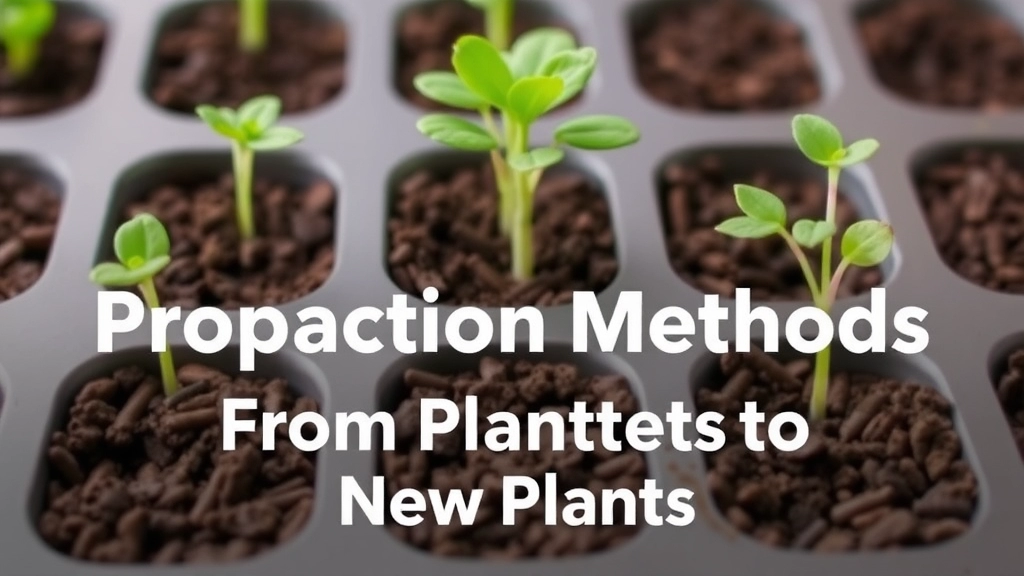
So, you’re loving your Kalanchoe Pink Butterflies and want to spread the joy? Propagation is a fantastic way to multiply your plants without breaking the bank.
Why Propagate?
- It’s cost-effective.
- You can share with friends.
- It’s a fun project!
Methods of Propagation
1. Leaf Cuttings
- Choose a Healthy Leaf: Snip a plump, healthy leaf from the parent plant.
- Let it Callous: Place it on a dry surface for a day or two to allow the cut end to callous over. This helps prevent rot.
- Plant it: Place the leaf in well-draining soil, keeping the cut end just below the surface.
- Water Sparingly: Mist lightly and keep it in bright, indirect light.
2. Offsets (Plantlets)
- Locate Offsets: These are baby plants that grow at the base of the parent.
- Gently Remove: Carefully pull them away from the main plant, ensuring some roots are attached.
- Plant Separately: Place these little ones in their own pots with the right soil mix.
- Water and Wait: Water lightly and give them a cozy spot with plenty of light.
3. Stem Cuttings
- Select a Healthy Stem: Cut a stem that’s at least 4-6 inches long.
- Callous Time: Like with leaves, let the cut end dry out for a day.
- Plant in Soil: Stick it in soil and water lightly.
- Bright Light: Keep it in a warm spot with indirect sunlight.
Tips for Success
- Use clean, sharp tools to prevent infection.
- Be patient! It can take a few weeks for roots to develop.
- Keep an eye on moisture; too much can lead to rot.
Propagation is not just about getting new plants; it’s about the joy of nurturing and watching them thrive.
Fertilization Needs and Schedule
When nurturing your Kalanchoe Pink Butterflies, understanding their fertilization needs is crucial for vibrant growth and blooming. Many plant enthusiasts often wonder how to provide the right nutrients without overwhelming their succulents.
Understanding Nutrient Requirements
Kalanchoe Pink Butterflies thrive on a balanced nutrient intake. Here’s a simple breakdown:
- Type of Fertilizer: Use a balanced, water-soluble fertiliser, ideally with an NPK ratio of 10-10-10.
- Frequency: Fertilize every 4-6 weeks during the growing season (spring and summer).
- Dilution: Always dilute the fertiliser to half the recommended strength to avoid nutrient burn.
Seasonal Adjustments
As seasons change, so do the fertilization needs:
- Spring/Summer: This is the active growing phase. Stick to the regular fertilization schedule.
- Autumn/Winter: Reduce or eliminate fertilization as the plant enters dormancy.
Observing Plant Health
Keep an eye on your Kalanchoe for signs of nutrient deficiency:
- Pale Leaves: Indicates a lack of nutrients.
- Stunted Growth: May suggest the need for fertilisation.
If you notice your Kalanchoe leaves drying out, it could be another sign of improper care. Additionally, knowing how to propagate Kalanchoe Pink Butterflies can help in maintaining a healthy plant collection. By monitoring these signs, you can adjust your fertilization schedule accordingly.
Common Problems: Pests and Diseases to Watch For
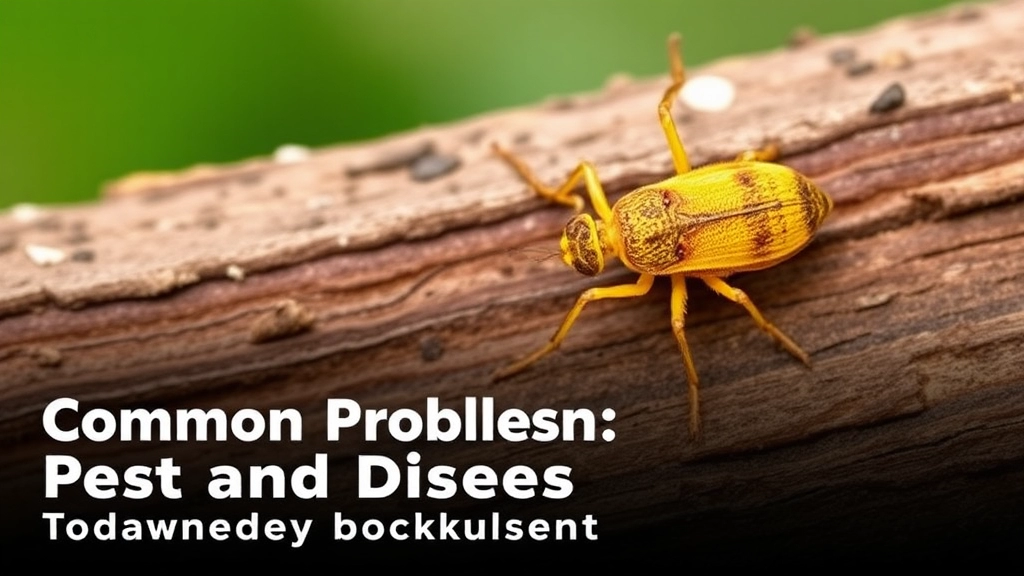
So, you’ve got your Kalanchoe Pink Butterflies thriving, but what happens when things go awry?
One of the biggest worries for plant parents is pests and diseases.
Here’s a quick rundown of what you might encounter:
Pests
- Mealybugs
- Look for cotton-like clusters on leaves.
- They suck sap, weakening your plant.
- Spider Mites
- Tiny and often invisible, but you’ll see webbing.
- They thrive in dry conditions.
- Aphids
- Small and green or black, they can multiply quickly.
- They also suck sap and can cause leaf curling.
Diseases
- Root Rot
- Caused by overwatering, leading to mushy roots.
- Look for yellowing leaves as a warning sign.
- Powdery Mildew
- A white, powdery substance on leaves.
- It thrives in high humidity and poor air circulation.
Prevention Tips
- Inspect Regularly
- Check your plants weekly for any signs of pests or diseases.
- Proper Watering
- Avoid overwatering to prevent root rot.
- Good Airflow
- Ensure your plant has enough space for air to circulate.
If you catch issues early, you can often resolve them without too much fuss.
IX. Pruning and Maintenance Techniques
Pruning is essential for maintaining the health and aesthetics of your Kalanchoe Pink Butterflies. You may wonder how to effectively prune this beautiful succulent to promote growth and blooming.
Why Prune?
- Encourages New Growth: Regular pruning stimulates the plant to produce new leaves and flowers.
- Removes Dead or Damaged Leaves: This keeps the plant looking tidy and prevents disease.
- Controls Size and Shape: Pruning helps maintain a compact and appealing form.
When to Prune
- Spring: The best time to prune is during the growing season, typically in spring. This allows the plant to recover quickly and thrive.
- After Blooming: Prune after the blooming period to encourage future flowers.
How to Prune
- Tools: Use clean, sharp scissors or pruning shears to avoid damaging the plant.
- Identify Areas to Cut: Focus on:
- Dead or yellowing leaves
- Spindly growth that detracts from the plant’s appearance
- Overcrowded sections that limit airflow
- Cut Above a Leaf Node: Make cuts just above a leaf node to encourage branching.
- Limit to 1/3 of the Plant: Avoid cutting more than a third of the plant at once to prevent shock.
Maintenance Techniques
- Regular Check-ups: Inspect your Kalanchoe Pink Butterflies every few weeks for signs of overgrowth or damage.
- Dusting Leaves: Gently wipe leaves with a damp cloth to remove dust, promoting better photosynthesis.
- Rotate the Plant: Rotate your plant every few weeks to ensure even light exposure, which helps maintain a balanced shape.
Choosing the Right Pot and Drainage for Healthy Growth
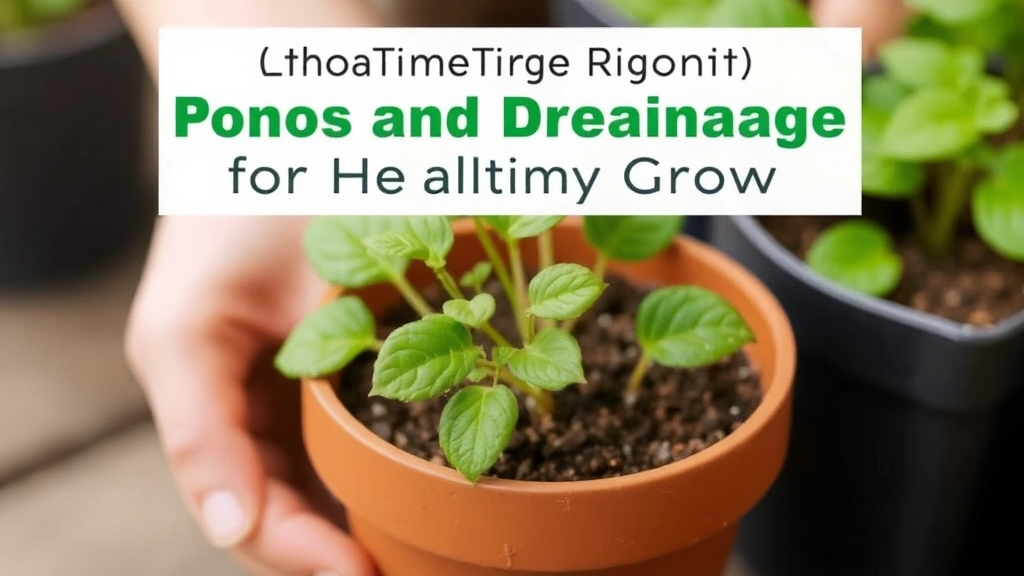
So, you’ve got your Kalanchoe Pink Butterflies all set up and ready to thrive. But have you thought about the pot? Choosing the right pot and ensuring proper drainage is crucial for keeping your succulent happy and healthy.
What to Look For in a Pot
- Material Matters: Terracotta pots are fantastic. They’re breathable and help wick away excess moisture. Plastic pots can work too, but make sure they have drainage holes.
- Size Counts: Go for a pot that’s about 2 inches larger than your current plant. Too big, and the soil might stay soggy; too small, and your plant won’t have room to grow.
- Shape and Style: While aesthetics are important, remember that a deeper pot can hold more soil, which helps with stability and moisture retention.
Drainage: The Unsung Hero
- Drainage Holes: Ensure your pot has good drainage holes. This is non-negotiable! Without them, your plant could drown.
- Add a Drainage Layer: Consider adding a layer of small stones or gravel at the bottom of the pot. This helps water flow away from the roots.
- Check the Soil: Use well-draining soil specifically designed for succulents. This will further enhance drainage and prevent root rot.
Pro Tip
If you’re feeling adventurous, try self-watering pots. They can help regulate moisture levels without the risk of overwatering.
How to Encourage Blooming in Kalanchoe Pink Butterflies
After ensuring your Kalanchoe Pink Butterflies are well-cared for, the next step is to encourage those stunning blooms that make this succulent so desirable.
Understanding Blooming Needs
Are you eager to see your Kalanchoe Pink Butterflies flourish with vibrant flowers? Here are some key factors to consider:
- Light Exposure:
- Place your plant in a bright location.
- Morning sunlight is ideal, while afternoon sun should be filtered to prevent leaf scorch.
- Temperature Regulation:
- Maintain a temperature between 18-24°C (65-75°F).
- Avoid drastic temperature changes, especially during the flowering period.
- Watering Schedule:
- Water thoroughly but infrequently.
- Allow the soil to dry out between waterings to prevent root rot.
Fertilization for Blooming
To promote blooming, you need to feed your Kalanchoe with the right nutrients:
- Use a Balanced Fertilizer:
- Opt for a water-soluble fertilizer with a ratio like 20-20-20.
- Apply every 4-6 weeks during the growing season (spring and summer).
Pruning for Encouragement
Regular pruning can also stimulate blooming:
- Remove Dead Flowers:
- Deadheading encourages new growth.
- Trim Leggy Growth:
- This helps the plant focus its energy on producing flowers rather than excessive foliage.
Seasonal Adjustments
Understanding the plant’s seasonal needs can make a big difference:
Seasonal Care: Preparing for Winter and Summer Changes
So, you’re wondering how to keep your Kalanchoe Pink Butterflies thriving through the seasonal shifts? You’re not alone! Many plant lovers worry about how their succulents cope with changing weather.
Winter Care
When winter rolls around, your Kalanchoe needs a little extra attention.
- Light: Keep it in a bright spot, ideally near a window. It loves that sunlight!
- Temperature: Aim for a cozy 15-20°C (60-68°F). Avoid chilly drafts.
- Watering: Cut back on watering. The plant goes into a bit of dormancy. Water only when the soil is completely dry.
Tip: If you notice the leaves getting wrinkly, it might be thirsty.
Summer Care
As the sun shines brighter, your succulent will perk up and demand more care.
- Light: Provide plenty of bright light, but be cautious of intense afternoon sun. A little shade can do wonders!
- Temperature: It thrives in warmer temps, but keep an eye on humidity. Too much can lead to rot.
- Watering: Increase your watering frequency, but still, let the soil dry out between sessions.
Tip: If the leaves start to look a bit dull, it might be time to give it a drink!
Transitioning Between Seasons
- Keep an Eye on the Weather: Sudden temperature changes can stress your plant. Gradually adjust its position to avoid shock.
- Monitor for Pests: Changes in temperature and humidity can invite unwanted guests. Regularly check for pests or signs of disease.
For more detailed care instructions, check out our Care Guide for Pink Butterflies Kalanchoe and learn about Winter Care Tips for Healthy Kalanchoe Plants.
FAQs About Kalanchoe Pink Butterflies Succulent
Where should I place my Kalanchoe Pink Butterflies for optimal light?
If you’re keeping it indoors, aim for a spot that gets plenty of bright, indirect sunlight, like near a south or west-facing window. For outdoor placement, a spot with morning sun and afternoon shade is ideal.
What type of soil is best for Kalanchoe Pink Butterflies?
Kalanchoe Pink Butterflies prefer a well-draining soil mix. A cactus or succulent mix with added perlite or pumice is excellent. You can also create a DIY mix with 50% cactus mix, 30% perlite, and 20% compost.
How can I propagate my Kalanchoe Pink Butterflies?
There are several methods to propagate your Kalanchoe Pink Butterflies:
- Leaf Cuttings: Snip a healthy leaf, let it callous, and then plant it in well-draining soil.
- Offsets (Plantlets): Remove baby plants growing at the base and plant them separately.
- Stem Cuttings: Cut a healthy stem, let it callous, and then plant it in soil.
What are common pests and diseases that affect Kalanchoe Pink Butterflies?
Common pests include mealybugs, spider mites, and aphids. Diseases to watch for are root rot and powdery mildew. Regular inspection and proper watering can help prevent these issues.
What kind of pot should I use for my Kalanchoe Pink Butterflies?
Choose a pot with good drainage holes. Terracotta pots are great because they are breathable. Ensure the pot is about 2 inches larger than your plant to allow room for growth.
How do I ensure proper drainage for my Kalanchoe Pink Butterflies?
Ensure your pot has drainage holes and consider adding a layer of small stones or gravel at the bottom. Use well-draining soil specifically designed for succulents to further enhance drainage.
Can I use self-watering pots for Kalanchoe Pink Butterflies?
Yes, self-watering pots can help regulate moisture levels without the risk of overwatering, making them a good option for Kalanchoe Pink Butterflies.
How often should I water my Kalanchoe Pink Butterflies?
Water sparingly. Allow the soil to dry out completely between waterings to prevent root rot.
Can Kalanchoe Pink Butterflies survive in low light conditions?
While they prefer bright, indirect light, you can supplement with grow lights if your indoor space is dim. However, they may not thrive as well in low light conditions.
What should I do if my Kalanchoe Pink Butterflies gets too much sun?
If your plant gets too much direct sunlight and starts to scorch, move it to a spot with partial shade or indirect light to prevent further damage.
References
-
Gardening Know How: Kalanchoe Pink Butterflies Care
-
The Spruce: How to Grow and Care for Kalanchoe Pink Butterflies
-
Succulent City: Kalanchoe Pink Butterflies Care Guide
